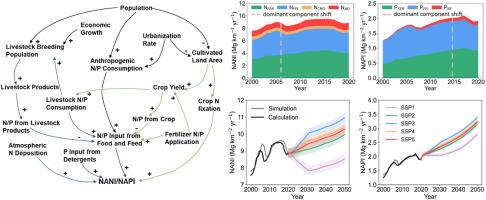珠江流域人为氮磷投入的社会经济驱动因素及未来预测
IF 10
1区 环境科学与生态学
Q1 ENGINEERING, ENVIRONMENTAL
引用次数: 0
摘要
过量的人为氮磷净输入(NANI和NAPI)是水生生态系统退化的关键驱动因素,导致水体富营养化和水质恶化。在这项研究中,我们旨在提高我们对NANI和NAPI的时空分布格局、相关驱动因素和潜在缓解策略的理解。为此,我们将NANI/NAPI框架与系统动力学模型相结合,开发了一个集成的建模系统。我们以珠江为例,应用了这一关联模型系统。珠江流域的NANI和NAPI表现出较大的空间变异性。结果表明,NANI和NAPI分别增长了25.7%和67.6%,并在2015年和2017年达到峰值。在未来气候变化情景下,2050年珠江流域NANI将减少2.9% (SSP1)或增加24.7% (SSP3),而NAPI将分别增加6.9% (SSP1)或66.5% (SSP3)。我们的研究结果强调了区域特定干预措施的紧迫性,即在城市化地区促进饮食转变和可持续农业,而不是在农村地区优化肥料使用。该框架为全球快速发展的流域的营养管理提供了可行的见解。本文章由计算机程序翻译,如有差异,请以英文原文为准。

Socioeconomic drivers and future projections of anthropogenic nitrogen and phosphorus inputs in the Pearl River Basin of China
Excessive net anthropogenic nitrogen and phosphorus inputs (NANI and NAPI) are key drivers of aquatic ecosystem degradation, leading to eutrophication and water quality deterioration. In this study, we aim to improve our understanding spatiotemporal distribution patterns, the associated driving factors and potential mitigation strategies of NANI and NAPI. To this end, we developed an integrated modeling system by coupling the NANI/NAPI framework with a system dynamics model. We applied this linked model system to the Pearl River as an illustrative example. The NANI and NAPI in the Pearl River basin showed large spatial variability. Our results indicated that the NANI and NAPI increased by 25.7 % and 67.6 % and peaked in 2015 and 2017, respectively. Under future climate change scenarios, NANI in the Pearl River Basin is projected to decrease by 2.9 % (SSP1) or increase by 24.7 % (SSP3) by 2050, while NAPI will rise by 6.9 % (SSP1) or 66.5 % (SSP3), respectively. Our findings highlight the urgency of region-specific interventions—promoting dietary shifts and sustainable agriculture in urbanized areas, versus optimizing fertilizer use in rural regions. This framework offers actionable insights for nutrient management in rapidly developing watersheds worldwide.
求助全文
通过发布文献求助,成功后即可免费获取论文全文。
去求助
来源期刊

Journal of Cleaner Production
环境科学-工程:环境
CiteScore
20.40
自引率
9.00%
发文量
4720
审稿时长
111 days
期刊介绍:
The Journal of Cleaner Production is an international, transdisciplinary journal that addresses and discusses theoretical and practical Cleaner Production, Environmental, and Sustainability issues. It aims to help societies become more sustainable by focusing on the concept of 'Cleaner Production', which aims at preventing waste production and increasing efficiencies in energy, water, resources, and human capital use. The journal serves as a platform for corporations, governments, education institutions, regions, and societies to engage in discussions and research related to Cleaner Production, environmental, and sustainability practices.
 求助内容:
求助内容: 应助结果提醒方式:
应助结果提醒方式:


